The idea of doggy dental care is relatively new to the scene of pet ownership. Many people can still recall dogs they had in their youth and think, ‘my old dog never needed his teeth brushed, or dental cleaning, or any of these supplements and stuff!’ Certainly when we consider the domesticated dogs’ closest cousin, the wolf, having to take care of our dog’s teeth seems redundant; When was the last time you heard of a brave intrepid soul journeying out to clean all the wild wolves’ teeth once a year, or brushing them once a day, or supplying them with supplements and bones to clean tartar from the teeth? By nature their cousins, the domesticated dog, should be able to maintain dental health on their own.
If you’re a client of ours with a smaller breed dog, there’s a decent chance that we’ve told you the bad news–your dog needs to see a vet because we found some issues. Unfortunately this is a common occurrence for small dogs and toy breeds like Toy Poodles, Yorkies, Pomeranians, and Mini Dachshunds, or breeds that have shorter skulls, brachycephalic dogs like Pugs, Bulldogs, Boxers, and some varieties of Mastiff. On the other end of the scale, we see large breed dogs like Labs, Huskies, German Shepherds, and more that never have to undergo dental surgery once in their life. Why is there this huge discrepancy between breeds with regards to dog dental care?
What has changed?
Well, firstly we can look at breeding; when you consider dogs being bred down from wolves, it’s a process that has only occurred over the last ~6500 years–considering the evolutionary scale, that’s a very short time! In that time, not much has changed about dogs (apart from appearance); Their dietary needs remain virtually the same, the physiology is the same, the behavior is the same, and there are still frequent cases of wolves and domesticated dogs interbreeding with fertile offspring–one of the requirements for two animals to be considered of the same species. If we look at their teeth, the evidence is solidified; even a chihuahua has the same number and kind of teeth as a wolf, proving that even the most ‘changed’ dog breeds are still relatives of their wild cousins. Modern dogs and wolves have 42 teeth at adulthood; 12 incisors for shredding and pulling, 4 canines for grip and deep tissue tearing, 14 sharp pointed premolars that function in preliminary grinding and breakdown, and 12 molars that grind and mash into palatable pieces.
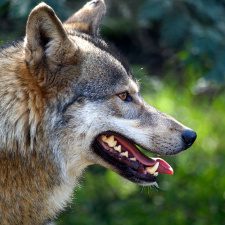
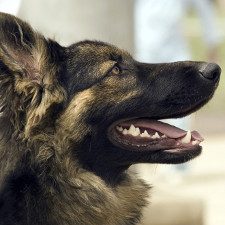
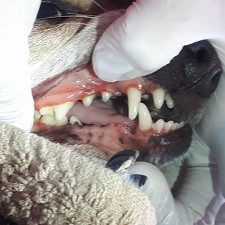
Looks pretty similar, right? So why do chihuahuas routinely need multiple dental surgeries through their life, while a wolf or a large breed like a german shepherd could often do without? One of the main components is size–as these toy breeds have become smaller and smaller, the teeth have been forced to cram into a jaw that is way too small, so the teeth become crowded together, rotated around, and stunted. This can create little areas between teeth where bacteria and debris can gather and become quite the nefarious nuisance, as well as pockets in the gum which can recess and lead to loose teeth. Another component is skull shape; Crowding issues are increasingly common in many domesticated dogs, especially in brachycephalic (short-nosed) breeds like pugs, bulldogs, boxers, and even larger bully breeds. When the teeth crowd and overlap it disables them from being properly accessed by materials that would be scraping the teeth clean like bones and other chews, and creates even more areas where bacteria can gather. Lastly, many designer breeds have simply not been bred for function and have undergone radical physical changes over the past few centuries. Pugs from 100 years ago looks very different from pugs today!
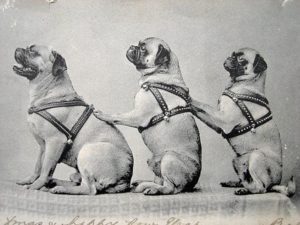
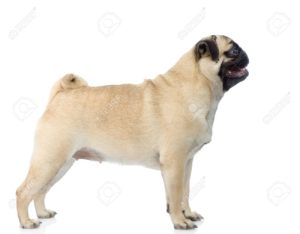
Although still immediately recognizable, we can see that the pug photo taken in the early 1900s shows a pug that has a distinct snout, smaller eyes that are better aligned, a head in proportion with the body, and a longer spine and legs. These distinct changes have been put into place through selective breeding for looks by people, not as a product of evolution. As cute and as amazing as these breeds are, unfortunately they were not genetically bred for success and function, particularly in the dental department.
Even if you brush your little dog’s teeth every single day, you may still be looking at a surgery at some point in their life. What, then, can you do to prevent that at any cost? Surprisingly enough, a huge component is diet!
You are what you eat!
Just like humans, who drink too much coffee and eat too much sugar and then suffer during biannual dental cleans, dogs are being fed diets that are detrimental to the health and cleanliness of the teeth.
Let’s start from the beginning–what exactly is food’s relationship with dental health? Studies have shown that the bacteria that constitutes plaque feed off of carbohydrates and produce acids. The acids that the bacteria produce wear down the enamel of the teeth and go into the bloodstream through the digestive system where they have shown to have an impact on the immune system. The more carbohydrates that are present in the mouth, the more favorable of an environment the mouth becomes for the growth and proliferation of bacteria, and therefore more acid is produced that wears down the enamel. The bacterial growth leads into plaque that hardens into tartar, which pushes up on the gum (causing redness and irritation) which can lead to serious periodontal disease and loose or rotten teeth.
Alongside carbohydrates, studies have shown that diets that are lacking in proper nutrition are leading to weaker immune systems–meaning that the body isn’t strong enough to fight off the bacteria that grows in the mouth. These studies are also showing that dental disease progresses faster and becomes more severe in pets and people that are being fed a nutrient poor diet. Already we can see that diet has a huge impact on the whole dog, much less just their teeth!
Now, this isn’t to say that carbohydrates are necessarily a bad thing–carbohydrates include sugars and starches, and are present in pretty well most food products available. Fruits are high in natural sugars, as well as grains and root vegetables. Carbohydrates are absolutely a necessary component of diet, as they produce the energy that our bodies use to run metabolic processes, a.k.a. the minute cellular and organ level processes that keep is alive and well. No carbs, and we mammals would all die! The issue is knowing when the amount of carbohydrates are excessive for the dietary needs of the animal.
Let’s talk Biology…
Dogs are carnivores, just like their wolf ancestors. ‘Carnivore’ doesn’t mean exclusively and only meat–it just means that most of their necessary nutrients and the main component of their diet is meat! Much like a cat (an obligate carnivore) will still chew on grass and eat plants, dogs can digest limited amounts of plant materials that have already been ground up or partially digested by their prey. Plant materials have cell walls which a dog’s body is not equipped to break down, hence why they have to be broken down and somehow processed for dogs to be able to receive the nutrients–and further showing that carbohydrates (most of which come nutritionally from plant materials) aren’t meant to be a huge component of a dog’s diet.
Dog’s bodies are naturally low-pH or acidic, which is the opposite of alkaline. A more alkaline environment is what creates cavities and damages the protective enamel, as you’ll recall. The naturally acidic environment of a dog’s mouth certainly does help protect against this, but the body’s pH is greatly influenced by diet; A dog being fed a diet high in carbohydrates is going to help proliferate bacteria in the mouth, which produces more low-grade acid, which shifts the acidic properties of a dog’s bodies to make it an even more friendly place for bacteria to grow and creating a bad environment for the teeth. Dogs simply aren’t equipped to handle high volumes of carbohydrates!
The Pet Industry
Unfortunately as pets have become more popular, many pet food manufacturers have searched for low cost ways to increase product for a booming consumer base. Many of these “hacks” come in the way of filler foods–grains like wheat and oats, millet, starches, corn, and sometimes even powdered cellulose (a.k.a. sawdust!). All of these things have one thing in common; They are very high in carbohydrates. Most ‘grocery store’ brands of kibble and wet food will have at least one or more of these ingredients within the first five ingredients on the ingredient list; as ingredients are listed by dry weight included in the product from highest to lowest, this is potentially a HUGE carbohydrate load for an animal that really doesn’t need that much!
How To Choose
So then, what makes a good food? It’s easy–balanced, well-sourced, and most of all meaty. Some grains can be okay for your dog particularly if they require a high fiber or low protein diet, but as it’s not something dogs can easily digest, grain-free tends to be the best. The first few ingredients should be meat: [animal], [animal organ], and sometimes [animal meal] are safe bets (as long as the animal is named). Avoid byproducts, as this can be anything on the animal not directly labelled, like beaks and feathers from poultry. Always look at the label! A lot of the vegetables that are in many pet diets are high carbohydrate and low nutritional value otherwise, like potatoes and sweet potatoes. This isn’t to say avoid these entirely, as they are important sources of fiber and great for digestive health, but be aware of how much starch and carbs they are getting versus the amount of meat, and know that there are other veggies that are lower starch and higher in other nutrients. Everything in moderation!
In terms of what the food itself is called, you do have to use some caution. As counterintuitive as it seems, some dental diets out on the market aren’t as great as they seem; They are called dental diets as the kibbles are bigger and this encourages chewing, reporting that the kibble scraping against the teeth will remove tartar–but think of it this way: you don’t eat crunchy cereal or cookies to clean your teeth at the end of the day do you? No! These crunchy carbs leave behind lots of debris on and between the teeth, and need to be brushed or picked out. The same thing applies to other regular kibbles with a similar consistency; Yes, the dog is chewing, but it’s still chewing the same thing that is leaving a good amount of debris on the teeth. When you look at the ingredients of these dental diets, often times you will see corn, wheat, and other grains within the top few ingredients–pretty counterintuitive to what carnivorous dogs should be eating!
From what we can see here, high carb diets are a big no if you want to keep your pet’s teeth clean, and the consistency of kibble isn’t enough on its own to provide any significant benefit to dental health. ‘Dental’ diets may not be as beneficial as they seem, and even some of the most well known brands cut corners to reduce cost. Wet food isn’t much better–you may be able to find on average a higher meat content and, for sure the added moisture is a bonus, but wet food sticks to the teeth just as bad.
If we are looking purely at diet and not including chewing habits/materials, brushing habits, or dental supplementation, the only diet that’s been found to have an impact on dental is whole meat diets with the appropriate ground greens and vitamins. These diets include freeze dried raw, dehydrated, home cooked, and raw diets. The high meat content keeps a dog’s natural pH well within the intended alkaline range that promotes good oral health and discourages the build up of hard calculus (tartar) while also creating an area that is unwelcoming to the bacteria that forms plaque. Not only are there thousands of testimonials from pet owners and vets alike, but we very often notice that the dogs that come to us that are fed a high-meat diet have lighter tartar that doesn’t stick to the teeth as badly–and many of these dogs have happier mouths as a result.
The Takeaway
Diet is an important component of a dogs life, but not every dog does well on the same diet. Raw isn’t for every dog, or every person! The most important thing to take away from this article is that excessive carbohydrates lead to a proliferation of tartar, and that dogs are biologically intended to consume a high-meat diet. Every animal needs carbohydrates to live, but as the adage goes; everything in moderation. Dogs and cats need diets that are mainly composed of meat, but dietary needs vary from animal to animal.
Knowing the ingredients you are giving to your dog and knowing its purpose is always good–do your own independent research, or ask your local pet store expert to guide you to a food that is right for your dog. Always check the labels of the foods you are feeding, do comparisons and trial runs, and don’t be afraid to ask for assistance. Please check out the articles listed below that were used in research for this article, and see for yourself how important diet is in dog dental care!
